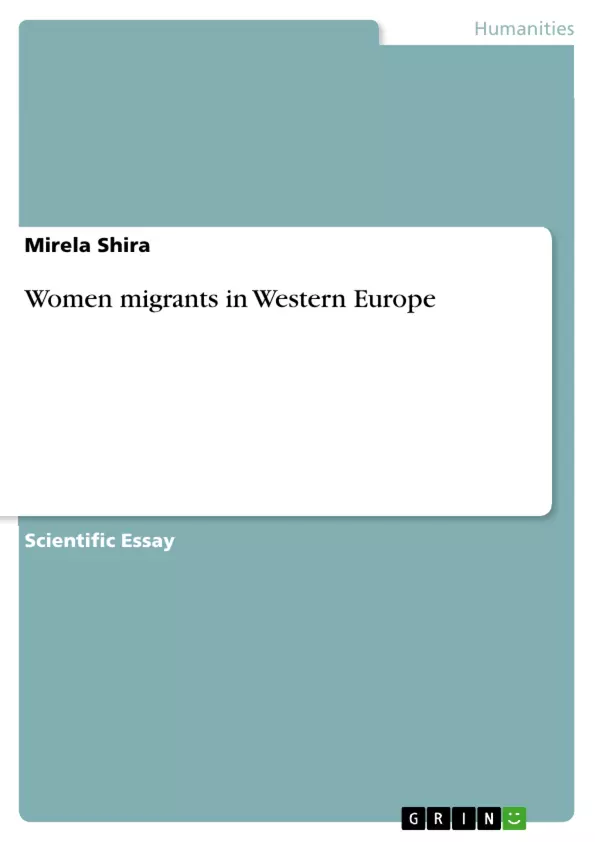Eighteen years ago, mobility in eastern and central Europe beyond national frontiers was rare. After the fall of the Berlin wall the migration from East to West was a significant trend in international patterns and mobility.
The relation between Eastern and Western Europe has been determined by the intensification of a variety of political, economic, and cultural exchanges between East and West. It is this human mobility, the transnational migration, its physical, cultural, political, subjective and conceptual form of movement, which play a central
role in these exchanges. We are living now in a world which is organised along multiple axes of mobility, circulation, flows of people and commodities.
The number of the migrants and especially that of women migrants has marked an increase in the recent years. The movement of people across Europe is changing the landscape of the continent. The migrants are becoming active subjects to their own
social life as well as to legal and political regulation amongst others.
Although the majority of the migrants are born in East Europe they are part of the European identity and they are taking responsibility for this transnational space of mediation and exchange called Europe.
Apart from countries and cultures there are also spaces of social interaction that determine the establishment of relationships. The transition from state socialism to capitalism has had a huge impact on the lives and the position of the women in Eastern European societies. This political change has been accompanied by the
intensification of multi-level communication between the European East and the West.
Inhaltsverzeichnis (Table of Contents)
- Mobility, gender and relationships
- The background of the women migrants from the Eastern Europe
- First impressions and experiences in the receiving countries
- Multiple belonging in comparison to fatherland.
- Migration and communication
- The migration of the Albanian women
Zielsetzung und Themenschwerpunkte (Objectives and Key Themes)
This preview aims to provide a comprehensive overview of the text, exploring the experiences and challenges faced by women migrants from Eastern Europe in Western Europe. The text examines the complexities of migration, its impact on gender roles, and the establishment of new relationships and social networks in a foreign environment. Here are some key themes:- The impact of mobility on gender and relationships, particularly for women migrants from Eastern Europe.
- The historical and political context of women's lives in Eastern Europe, leading to migration.
- The challenges and opportunities presented by integration in a new country and culture.
- The significance of communication, social networks, and the role of institutions in facilitating integration.
- The complexities of navigating multiple identities and belonging in both the homeland and the adopted country.
Zusammenfassung der Kapitel (Chapter Summaries)
Mobility, gender and relationships
This chapter explores the motivations behind migration from Eastern to Western Europe, focusing particularly on the experiences of women. It discusses the role of relationships in both initiating and shaping the migration experience, examining the challenges of establishing new connections and maintaining existing ones across borders. It also highlights the impact of mobility on gender roles and expectations in both the sending and receiving countries.The background of the women migrants from the Eastern Europe
This chapter examines the historical and political context of women's lives in Eastern Europe, providing a backdrop for understanding the motivations behind migration. It analyzes the legacy of state socialism, its impact on gender roles and women's participation in the workforce, and the subsequent challenges faced by women during the transition to capitalism.First impressions and experiences in the receiving countries
This chapter explores the initial experiences of women migrants upon arrival in Western Europe, focusing on the process of adaptation, the formation of social networks, and the challenges of navigating a new culture. It delves into the importance of communication, language acquisition, and the role of institutions in facilitating integration.Multiple belonging in comparison to fatherland
This chapter examines the complexities of identity and belonging for women migrants, navigating their relationships with both their homeland and their adopted country. It explores the emotional and psychological challenges of living between two cultures, the potential for conflict and alienation, and the search for a sense of belonging in a new environment.Migration and communication
This chapter delves into the importance of communication in the migration experience, emphasizing its role in facilitating integration, building relationships, and navigating cultural differences. It examines the language barriers faced by women migrants, the strategies they develop to communicate effectively, and the role of communication in fostering a sense of belonging.The migration of the Albanian women
This chapter explores the specific experiences of Albanian women migrants, providing a case study to illustrate the broader themes of the book. It examines the unique challenges faced by Albanian women due to factors such as language, cultural norms, and the history of migration from Albania.Schlüsselwörter (Keywords)
The text centers on the themes of women migration, Eastern Europe, Western Europe, gender, relationships, integration, identity, communication, and social networks. It explores the complex realities of women's experiences in the context of migration, highlighting the intersection of individual choices, social structures, and political contexts.- Arbeit zitieren
- Mirela Shira (Autor:in), 2008, Women migrants in Western Europe, München, GRIN Verlag, https://www.grin.com/document/201641



